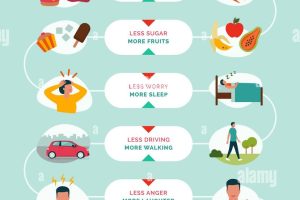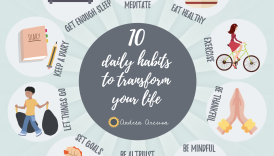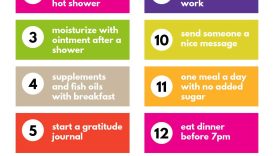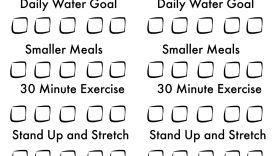Mastering the Art of Balance: Crafting Your Perfect Healthy Lifestyle Plan

Introduction: Understanding the Importance of Balance in a Healthy Lifestyle
In our fast-paced world, it’s easy to get swept away by the demands of life, often neglecting our health. To truly thrive, one must recognize the essence of balance—a harmonious coexistence of various aspects of life.
- Mastering the Art of Balance: Crafting Your Perfect Healthy Lifestyle Plan
- Introduction: Understanding the Importance of Balance in a Healthy Lifestyle
- Defining Balance in Health
- Benefits of Achieving a Balanced Lifestyle
- Setting the Foundation: Assessing Your Current Lifestyle
- Self-Reflection and Goal Setting
- Understanding Your Priorities
- Nutrition: Fueling Your Body for Optimal Health
- Balanced Diet Essentials
- Meal Planning Tips
- Exercise: Building a Sustainable Fitness Routine
- Types of Exercise for Overall Wellness
- Creating a Workout Schedule
- Mental Health: Nurturing Your Mind and Spirit
- Stress Management Techniques
- Prioritizing Self-Care Practices
- Sleep and Rest: Prioritizing Recovery for Overall Well-Being
- Importance of Adequate Sleep
- Establishing a Relaxing Bedtime Routine
- Social Connections: Cultivating Healthy Relationships
- Building a Supportive Social Circle
- Balancing Social Time with Solitude
- Time Management: Finding the Right Work-Life Balance
- Setting Boundaries for Work and Personal Time
- Maximizing Productivity Through Time Management Techniques
Defining Balance in Health
Balance in health means allocating appropriate time and energy across essential areas: nutrition, exercise, mental health, sleep, and social connections. It’s about avoiding extremes; instead of overindulging or depriving oneself, finding moderation is key. This could mean enjoying a slice of cake during a celebration while also ensuring that plenty of fruits and vegetables fill your meals.
Benefits of Achieving a Balanced Lifestyle
Embracing a balanced lifestyle offers numerous advantages, such as:
- Enhanced Physical Health: A nutritious diet and regular exercise can reduce the risk of chronic diseases.
- Improved Mental Clarity: Balancing work and rest allows for better focus and productivity.
- Stronger Relationships: Prioritizing social connections helps foster a supportive community.
- Increased Energy Levels: Proper rest and nutrition lead to sustained energy throughout the day.
By implementing these principles, individuals can cultivate a more fulfilling and harmonious life.
Setting the Foundation: Assessing Your Current Lifestyle
Before embarking on the journey toward a balanced lifestyle, it’s essential to take a step back and assess where you currently stand. This assessment lays the groundwork for meaningful change.
Self-Reflection and Goal Setting
Self-reflection is a powerful tool. Consider asking yourself questions like:
- What habits contribute positively to my life?
- Are there behaviors I wish to change?
- What does a balanced lifestyle look like to me?
To give more clarity, creating SMART goals—Specific, Measurable, Achievable, Relevant, and Time-bound—can be extremely beneficial. For example, instead of saying, “I want to eat healthier,” aim for “I will include at least two servings of vegetables in my meals three times a week.”
Understanding Your Priorities
Next, understanding your priorities helps in aligning your actions with your goals. Begin by listing your top five priorities, which might include:
- Family time
- Career advancement
- Physical fitness
- Mental well-being
- Hobbies
Once you have your priorities laid out, assess where your current lifestyle aligns or misaligns with these values. This clarity will help ensure that every step you take leads you toward a balanced and fulfilling lifestyle.
Nutrition: Fueling Your Body for Optimal Health
Once you have a clear understanding of your priorities, the next step is to focus on one of the cornerstones of a balanced lifestyle: nutrition. The food we consume plays a vital role in how we feel both physically and mentally.
Balanced Diet Essentials
A balanced diet consists of various food groups that provide all the essential nutrients your body needs. Think of it like building a colorful plate that includes:
- Fruits and Vegetables: Aim for a variety of colors; each hue often represents different vitamins and minerals.
- Proteins: Lean meats, beans, and nuts help build and repair tissues.
- Whole Grains: Foods like brown rice and whole-grain bread provide energy and fiber.
- Healthy Fats: Incorporating sources like avocados and olive oil supports brain health.
Meal Planning Tips
Meal planning can simplify your journey to a balanced diet. Consider these practical tips:
- Plan Ahead: Dedicate time each week to plan your meals, making shopping easier.
- Batch Cooking: Prepare larger portions of recipes and store them for busy days.
- Flexible Recipes: Use versatile ingredients that can adapt to different meals. For example, grilled chicken can star in salads, wraps, or stir-fries.
By prioritizing these nutritional essentials and meal planning strategies, you’ll ensure your body receives the fuel it needs for optimal health.
Exercise: Building a Sustainable Fitness Routine
Having established a solid foundation in nutrition, it’s now time to turn your attention to exercise—another critical component of a balanced lifestyle. Embracing physical activity not only enhances physical health but also boosts mental well-being.
Types of Exercise for Overall Wellness
When it comes to exercise, variety is key. Incorporating different types of activities can keep your routine enjoyable and holistic. Here are some essential categories to consider:
- Cardiovascular Exercise: Activities like running, cycling, or swimming improve heart health and increase endurance.
- Strength Training: Lifting weights or doing bodyweight exercises like push-ups builds muscle and improves metabolism.
- Flexibility and Balance: Practices like yoga or Pilates enhance flexibility and stability, reducing injury risk.
- Recreational Activities: Dancing, hiking, or joining a sports team can be fun ways to stay active.
Creating a Workout Schedule
Designing a workout schedule is crucial for consistency. Here’s a simple framework to help you get started:
- Choose Your Days: Aim for at least 150 minutes of moderate-intensity exercise weekly, spread over several days.
- Mix It Up: Alternate between strength, cardio, and flexibility workouts to prevent boredom.
- Listen to Your Body: Don’t hesitate to adjust your schedule based on how you feel; rest days are just as important for recovery.
With a sustainable fitness routine, you’ll be well on your way to not just improved health, but a more balanced and fulfilling life.
Mental Health: Nurturing Your Mind and Spirit
With your nutrition and exercise routines dialed in, it’s essential to focus on mental health—often the most overlooked aspect of a balanced lifestyle. Nurturing your mind and spirit is equally important for achieving overall well-being.
Stress Management Techniques
Stress is a common element in our daily lives, but managing it effectively can change the game. Here are some techniques to consider:
- Mindfulness Meditation: Practicing mindfulness helps you stay present, reducing anxiety and promoting calm.
- Deep Breathing Exercises: Taking a few moments to breathe deeply can lower stress levels significantly.
- Physical Activity: Incorporating exercise into your routine releases endorphins, which can improve your mood.
Prioritizing Self-Care Practices
Self-care isn’t just a trend; it’s a necessity for your mental health. Here are some practices to make self-care a priority:
- Schedule “Me Time”: Block out time each week for activities you enjoy—reading, painting, or simply soaking in a bath.
- Limit Screen Time: Disconnect from devices to recharge your mind; a digital detox can do wonders.
- Connect with Nature: Spend time outdoors, whether it’s walking in a park or gardening, to enhance your mood and peace of mind.
By implementing these techniques and practices, you’ll foster not only mental resilience but also a more harmonious and balanced life overall.
Sleep and Rest: Prioritizing Recovery for Overall Well-Being
Having cultivated mental health through stress management and self-care, it’s critical to turn our attention to another vital aspect of a balanced lifestyle: sleep and rest. Adequate sleep is essential not just for recovery, but for overall well-being.
Importance of Adequate Sleep
Sleep is the body’s way of rejuvenating itself. Quality rest allows for important processes such as:
- Physical Recovery: Sleep helps the body repair tissues and build muscle.
- Mental Clarity: A well-rested mind enhances concentration, decision-making, and memory.
- Emotional Stability: Poor sleep can lead to irritability and increased anxiety levels.
Incorporating better sleep habits can truly transform your life. For example, when I started prioritizing sleep, I noticed a significant improvement in my mood and focus throughout the day.
Establishing a Relaxing Bedtime Routine
Creating a calming bedtime routine can signal your body that it’s time to wind down. Consider implementing these steps:
- Set a Consistent Sleep Schedule: Go to bed and wake up at the same time daily, even on weekends.
- Limit Screen Exposure: Try to unplug from devices at least an hour before bed.
- Create a Relaxing Atmosphere: Dim the lights, play soft music, or read a book to get in the right mindset.
By placing a strong emphasis on sleep and rest, you’ll nurture your body and mind, paving the way for a more balanced and fulfilling lifestyle.
Social Connections: Cultivating Healthy Relationships
As we’ve explored the importance of sleep and rest, let’s turn our focus to another critical element of a well-rounded lifestyle: social connections. Cultivating healthy relationships enriches our lives and significantly contributes to our emotional and mental well-being.
Building a Supportive Social Circle
Having a supportive social circle can make a world of difference. Surrounding yourself with positive, like-minded individuals fosters encouragement and growth. Here are some ways to build such a network:
- Join Community Groups: Engage in clubs or organizations that match your interests, whether it’s a book club or a fitness class.
- Reconnect with Old Friends: Sometimes, reaching out to long-lost friends can reignite meaningful connections, offering fresh perspectives.
- Be Open: Sharing your thoughts and feelings with close ones can deepen connections and provide mutual support.
Balancing Social Time with Solitude
While social interactions are vital, balancing them with solitude is equally important. Here’s how to find that harmony:
- Schedule Downtime: Just as you plan social events, allocate time for yourself to recharge.
- Listen to Your Needs: Some days, you might crave socializing, while others may call for a quiet evening at home—listen to your instincts.
- Engage in Solo Activities: Hobbies like reading or gardening not only bring joy but also allow for self-reflection.
By nurturing social connections while valuing solitude, you create a balanced life rich in relationships and self-discovery.
Time Management: Finding the Right Work-Life Balance
Having established the importance of social connections and personal downtime, let’s delve into a fundamental aspect of achieving a balanced lifestyle: time management. Striking the right work-life balance is essential for maintaining both productivity and personal fulfillment.
Setting Boundaries for Work and Personal Time
Effective boundaries can significantly enhance your well-being. Here are some strategies to create clear distinctions between work and personal time:
- Designate Work Hours: Set specific times for starting and ending your workday, and stick to them.
- Create a Workspace: If working from home, establish a dedicated space for work to help mentally separate it from personal activities.
- Communicate Your Needs: Let family members and colleagues know your boundaries to ensure mutual respect for your time.
Maximizing Productivity Through Time Management Techniques
To make the most of your day, consider employing effective time management techniques:
- The Pomodoro Technique: Work in focused intervals (typically 25 minutes), followed by a 5-minute break. This can boost concentration and prevent burnout.
- Prioritize Tasks: Make daily to-do lists and rank tasks by importance. Focus on completing high-priority items first.
- Use Time Blocking: Allocate specific blocks of time for various tasks to ensure that you give appropriate focus to work and personal life.
By mastering time management, you’ll not only boost your productivity but also enhance your overall work-life balance, bringing you closer to a fulfilling and harmonious lifestyle.





